- Home
- Salman Rushdie
The Jaguar Smile Page 4
The Jaguar Smile Read online
Page 4
‘What attacks?’
His serenity threw me into a spin. Confused, I stupidly said, ‘Well, for example, on Nicolás Guillén,’ who is the head of the Cuban Writers’ Union, when I had meant to say, ‘Padilla.’ He looked at me scornfully. ‘In the early days there were a few abuses,’ he said. ‘But not now.’ I asked a few more questions — what about Armando Valladares’ book, Against All Hope, which speaks of over two decades in Cuban prisons, two decades of being made to eat shit and drink soup containing bits of glass? But it was like hitting a wall.
When I left the Ministry of Culture I noticed that the Nicaraguan fondness for naming their ministries acronymically had created, in this instance, an unfortunately Orwellian resonance. Cardenal, chief of MINICULT. I went away feeling depressed.
I had lunch with a man from the FSLN’s newspaper, Barricada. He was responsible for the ‘Editorial’ page, and I have forgotten his name, which is perhaps just as well, because he made the most chilling remark I heard in Nicaragua. I was arguing with him about censorship in general and the recent closure of La Prensa in particular. He seemed, at first, genuinely opposed to censorship — ‘of course, as a working journalist, I hate it too’ — but then he said this: ‘A worker I met recently put it very well. If a mother has a sick child, very sick, she takes it to the hospital without first putting on her make-up.’
My depression deepened. ‘So,’ I asked unhappily, ‘are such matters as the freedom of the press just cosmetic?’
His face lit up, and he nodded enthusiastically. ‘Cosmetic, that’s the word. Yes.’
‘Everybody censors the press in wartime.’ That was the official line on the subject, and I heard it from my anonymous Barricada friend, from Daniel Ortega, from all quarters. It wouldn’t do. I remembered being in Pakistan during the 1965 war with India, and how it felt to be fed information about which the only certain thing was that it was hopelessly and deliberately misleading. I remembered learning to divide Pakistani claims to have shot down Indian planes by ten, and to multiply the admitted losses by the same factor. Then the two figures began to balance up, and you had the illusion of truth. I remembered, too, my outrage at the British government’s manipulation of the news media during the Falklands/Malvinas war. What had been unacceptable to me there was also unacceptable here.
The issue of press freedom was the one on which I absolutely parted company with the Sandinistas. It disturbed me that a government of writers had turned into a government of censors. Largely because of this issue, a kind of silent argument raged in my head throughout my stay. I would tell myself that something remarkable was being attempted here, with minimal resources and under great pressure. The land reforms, and the health and literacy campaigns of 1980 and 1981, the years before the start of US aggression, showed what could be achieved. The literacy campaign, for instance, had brought the percentage of illiterate Nicaraguans down from more than fifty per cent to less than twenty per cent in two years. Now, however, the diversion of manpower into the war effort meant that the initial campaign had not been properly followed up, and illiteracy was creeping forward once again, like a jungle reclaiming a neglected clearing … Then I would argue back: those campaigns are all very well; but they think that dissent is cosmetic. And Barricada is the worst paper I’ve seen in a long while.
The argument usually ended in the same place. Nicaragua was an imperfect state. But it was also engaged in a true revolution: in an attempt, that is, to change the structures of society in order to improve the lives of its citizens. And imperfection, even the deep flaw of censorship, did not constitute a justification for being crushed by a super-power’s military and economic force.
Mario Vargas Llosa wasn’t in Nicaragua, but in the quiet of my room I would dispute with him, too. He had written and spoken so frequently, and with such skill, about the importance of supporting the democratic process in Latin America; he insisted that it was the only way to break the cycle of revolution and dictatorship. He justified his support for parties and governments of the right in his native Peru by saying that he preferred ballots to bullets; that a flawed democracy was infinitely preferable to no democracy at all.
Peru was a flawed democracy of the right. Nicaragua was a flawed democracy of the left. If democracy were really Vargas Llosa’s goal, then Nicaragua, according to his own declared principles, was exactly the kind of state he ought to be supporting, and fighting to improve.
I wondered, into the silence, why he did not.
5
ESTELÍ
At five a.m. on the morning of 19 July, the day of the seventh anniversary celebrations, I went to the home of Daniel Ortega and his wife, the poet Rosario Murillo. After getting past the usual compound walls and guards, I entered a rambling bungalow of many verandahs and large numbers of carved wooden rocking-chairs. The decor reflected Rosario Murillo’s interest in the country’s arts and crafts: there were brightly coloured wooden animal mobiles dangling from the beams, and pottery decorated with pre-Columbian motifs, and cushions covered in the softened bark of trees. The house revealed very little about Comandante Daniel, for whom, it seemed, reticence had become (had always been?) second nature. Children’s toys, and indeed children, were everywhere. There was no shortage of little Ortegas, and many of them, I noted, were wearing ‘Masters of the Universe’ T-shirts, featuring the eternal battle of He-Man and Skeletor; another indication of the omnipresence of US culture.
The Sandinista leadership assembled. This year, the main ‘Acta’ or celebratory event was to be held at Estelí, the northern town, just forty kilometres from the Honduran frontier, that had always been solidly behind the Frente. (Even the local bishop was the most amenable member of the Nicaraguan church hierarchy.) The decision to hold the Acta at Estelí was an act of defiance, and it was a racing certainty that the Contra forces would be doing their best to ruin the day. ‘We will show them we can defend our frontier,’ Daniel Ortega said.
Pragmatically, four of the FSLN ‘nine’ stayed behind in Managua, as did Sergio Ramírez. We set off in convoy, preceded by the now-familiar outriders in their orange washing-up gloves. Their hands, I thought, must get terribly hot and sticky in there.
The Nicaraguan people knew what to do when the rubber gloves approached: they got out of the way. We zoomed northwards. Daniel Ortega drove his own, black Landcruiser. I travelled behind him with Rosario Murillo and two of the ‘nine’, the agriculture minister Jaime Wheelock and the FSLN’s political chief, Bayardo Arce, in Comandante Arce’s vehicle. Arce looked impatient as we bowled along (he has a reputation for being something of a speed merchant). Scarecrow Ronald Reagans hung — by the neck — from roadside trees.
Arce munched on an enormous cigar as we crossed the bridge at Sébaco. ‘It would be a good day,’ he remarked absently, ‘for the contra-revolución to attack a bridge.’
‘Hmm,’ I agreed, keeping my voice deep and courageous. The road was lined with members of the peasant militias in fatigues, carrying their Kalashnikovs. ‘We decided to use the militias for security purposes today,’ Arce said. ‘We couldn’t pull the troops in from the frontier, as you’ll understand.’
‘Hmm,’ I agreed again. In Sébaco, I noticed, you could go and play bingo at the Red Cross building. They obviously didn’t get too much work, I reassured myself.
‘The security seems excellent,’ I mumbled. Jaime Wheelock, baby-faced and friendly, grimaced. ‘There are a lot of roads,’ he said. ‘We can’t guarantee that they are all safe.’
‘Oh,’ I said. ‘I see.’
Wheelock was worried that the Contra would hide out along the smaller mountain roads and ambush the campesinos as they made their way to Estelí. Many rural communities had been instructed not to try and make the trip into town for the Acta for this reason. ‘We are trying to keep it as much of a local event as possible,’ Wheelock said. ‘In a way it’s a tribute to the people of Estelí, who have sacrificed very much.’
The mountains were closing in ahead of us.
We were in a heavily cultivated valley, and suddenly Wheelock launched into his favourite subject: agrarian reform. It was extraordinary the way that cherubic countenance would light up the moment the talk got round to pigs or coffee or rice. In this valley, he said, the mixed economy was functioning perfectly. That, over there, was a large private farm, and there were some small private farmers and over there, state-owned farms. The state offered the private sector expert advice, technical assistance and even acted, at peak harvest times, as a supplier of labour.
‘The campesinos used to be forcibly shunted around the country under Somoza, didn’t they?’ I asked. ‘So how is it that they are so willing to become travelling labourers for the revolution?’
‘Obviously we don’t make them move by coercion,’ Arce spoke, his words sidling past the obstacle of his cigar. ‘It requires persuasion, political work.’
Wheelock said, ‘It’s because we have given them land. Now they have their own land, they have a base. And then different harvests happen at different times, so it is a way for them to use their slack periods profitably.’
‘Still, it’s surprising they’re willing to be so mobile,’ I said.
Wheelock smiled happily. ‘It is because they have great trust in the revolution, now.’
O the beauty of the mountains at Estelí. They sprang from the earth in improbable, contorted forms, in shapes plenty of fantasy, as the old tobacco map had put it. Sixty or seventy thousand of us had crowded into the plaza, cradled by the mountains’ encircling arms. Banners waved: power to the people. And, on the Tannoy, as we waited for the Acta to get under way, there was 1950s rock music. Estelí danced to ‘Rock Around the Clock’.
Backstage, in a hospitality room under the main stand, the Sandinista leadership was receiving messages from the front. Short-wave radio brought the news that two large Contra groupings had been identified, and had crossed the frontier into Nicaragua. Ortega, Arce, Wheelock and the others went out to greet the crowd.
Daniel Ortega would never be a natural orator, but according to the old hands I asked, he had become much, much better at public speaking than he used to be. ‘You should have heard him last year,’ one party worker whispered to me. ‘Phoo!’
I thought he spoke simply and well, if a little stilted when he waxed rhetorical. He said, not for the first time, that Reagan was ‘worse than Hitler’, and that was plain silly. But he was much more effective when he listed the numbers of teachers, doctors, volunteer workers and campesinos who had died in the last year, and spread his arms wide after each statistic to demand from the people: ‘Quién es culpable?’ (Who is to blame?) And they roared back their answer: ‘Reagan.’
One day, he said, when Nicaragua was at peace, history would remember there was a nation that would not lie down and be crushed.
‘Patria libre!’
‘O MORIR.’
That evening we were back in Managua, and the good news was that the the Contra had not managed to do a single thing all day. No roads had been mined, no campesinos attacked, no bridges blown. Nada. At the old Somocista country club, Managua was having a party. Salsa and bossa nova music filled the night sky. I looked at the dancers and thought that it was not the moment for an escritor hindú to disgrace himself by attempting to compete with such performers.
Somebody took my elbow. I turned to find a small, elderly gentleman with a cane nodding meaningfully at me. He was, of course, a poet. ‘I greatly admire,’ he said to me, ‘your Indian poet, Tagoré.’
I was taken aback. What was old Rabindranath doing here, with this accent on his final e? ‘Is he translated here?’ I asked.
‘Victoria Ocampo, the great Argentine editor and intellectual, fell in love with the work, and with the man,’ came the reply. ‘I do not know, however, if they had an affaire. I suspect not. But Victoria Ocampo was determined that Latin America should discover this great genius, and she published many excellent translations.’
‘Then Tagore is better read in Latin America than in India,’ I said. ‘There, many of the translations are very bad indeed.’
‘Tagoré,’ he corrected me. ‘I admire him for his spiritual qualities, and also his realism.’
‘Many people think of Latin America as the home of anti-realism,’ I said. He looked disgusted. ‘Fantasy?’ he cried. ‘No, sir. You must not write fantasy. It is the worst thing. Take a tip from your great Tagoré. Realism, realism, that is the only thing.’
I escaped from the admonitory shade of Rabindranath and sat down with Rosario Murillo and Hugo Torres, the Frente’s political education chief (and, what else, a poet). Also at the table were Susan Meiselas, the American photographer whose work in Salvador and Nicaragua I had long admired, and an American film producer, Burt Schneider. I arrived as Rosario was wondering how the people of the USA could tolerate what their government was doing to this tiny country.
‘You’ve got to understand that for Americans, Nicaragua has no reality,’ said Burt, a tall rawboned man with long arms and large gestures. ‘To them it’s just another TV show. That’s all it is.’ He went on to argue that the US would never invade Nicaragua because of the memory of Vietnam. Susan Meiselas said she found it hard to be so optimistic. So did I; in neoconservative America, the lesson of Vietnam seemed to be that the real mistake had been to quit when they did, instead of staying to finish the job.
‘The trouble is, Rosario,’ Schneider cried, ‘nobody knows if you’re communists. Hell, I don’t know myself. What do you reckon, Susan?’ He leaned conspiratorially across the table to Meiselas, ‘Does she look like a Commie to you?’ Schneider had known Rosario a long time, and she and Torres both smiled politely, but the joke fell pretty flat.
In the background, the nine comandantes de la revolución were having their picture taken. It was the only time I ever saw them all together, and my only glimpse of Tomás Borge, a tiny gnome with a large cigar.
‘Look at them,’ Burt said lovingly. ‘Looks like a school photo, doesn’t it? Isn’t it a privilege to be here with them, on this day?’
‘Yes,’ I said, ‘it is.’ Happy birthday, Nicaragua. I drank a toast in the best rum in the world, Flor de Caña Extra Seco. Mixed with Coke, it was called a Nica-libre, and after a few glasses I was ready to take on the salsa champions and knock them dead. I went outside to dance.
6
THE WORD
In the octagonal church of Santa María de los Ángeles in the Riguero barrio of Managua, Father Uriel Molina stood in full regalia in front of a packed congregation with a pop group at his back. The modern church looked like a tepee of metal girders. Its walls were covered in luridly coloured murals. Sandino, wearing his hat even though he was in church, and Carlos Fonseca, his goatee and specs looking iconically, as they always did, up and into the future, were both present on the walls, but on modest side-panels, playing a strictly supporting role, on this occasion, to Christ and his angels.
(The characteristic Fonseca pose was clearly based on the old images of Lenin thrusting his beard forward, ever forward. It struck me that, in this supposed hotbed of Marxism-Leninism, this was as close to a picture of Lenin as I’d come. I did, eventually, get to see both Vladimir Ilyich and the old bastard Marx himself: their portraits flanked a rather bemused-looking Sandino at the headquarters of the biggest trade union, the CST [Central Sandinista de Trabajadores]. Compared to, for example, Kerala, where graffiti of Lenin speaking Malayalam sprouted on every second wall, and trucks could be named STALIN JOSÉ, the Reds in Nicaragua were keeping a pretty low profile.)
I had come out to this poor barrio, whose people had been prominent in the insurrection, to hear the ‘Misa Campesina’, the peasants’ mass created by Ernesto Cardenal and Carlos Mejía Godoy, whose gift for the hummable tune might be envied by Paul McCartney. The Misa Campesina was one of the most striking manifestations of liberation theology, which, in Nicaragua, had introduced into church services such versicles-and-responses as: ‘Between the Church and the Revolution/There is no contradi
ction.’ I had also wanted to get a look at Father Molina, one of the most visible of the liberation-theology priests, an early influence on Luis Carrión, and the founder of the Valdivieso Centre, at which the ideas of the Popular Church were hammered out. The expelled Bishop Vega had attacked the Valdivieso Centre people as a bunch of liars. ‘The problem is that they use the Marxist method. For a Marxist … to tell a lie is valid because with it you can better implant the ideology.’ And the American journalist Shirley Christian, in her book Nicaragua: Revolution in the Family, a book that was waspishly hostile to most aspects of post-Somoza Nicaragua (and, among other things, presented a sympathetic portrait of an escaped Somocista officer of the National Guard, Leo Salazar, who called Somoza ‘a wonderful man’), described Father Molina as ‘a television talk-show host.’
He was certainly flamboyant, something of a showman, a priest familiar with the hand-held microphone. He led the service with a theatrical jauntiness that had clearly offended Ms Christian. I, however, infidel that I was, quite enjoyed it.
The guitars and drums struck up a tune, and the lead singer sang:
Vos sos el Dios de los pobres,
el Dios humano y sencillo…
‘You are the God of the poor,
the human and simple God,
the God with the work-hardened face,
that’s why I talk to you …
just as my people do,
because you are the worker God,
you are the labourer-Christ.’
The tunes of the Misa Campesina were real foot-tappers; the lyrics continued in this quotidian vein. ‘Identify yourself with us, O Lord,’ they asked at one point, in a revealing reversal — after all, it was more traditionally the role of the faithful to identify themselves with the deity — ‘Show us your solidarity.’ The God of the Poor had to earn the people’s belief, by being one of them.

 Shame
Shame The Enchantress of Florence
The Enchantress of Florence Imaginary Homelands: Essays and Criticism 1981-1991
Imaginary Homelands: Essays and Criticism 1981-1991 Joseph Anton: A Memoir
Joseph Anton: A Memoir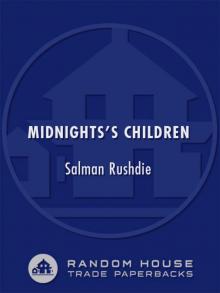 Midnight's Children
Midnight's Children East, West: Stories
East, West: Stories Luka and the Fire of Life
Luka and the Fire of Life Fury Fury Fury
Fury Fury Fury Haroun and the Sea of Stories
Haroun and the Sea of Stories Step Across This Line: Collected Nonfiction 1992-2002
Step Across This Line: Collected Nonfiction 1992-2002 The Satanic Verses
The Satanic Verses The Moor's Last Sigh
The Moor's Last Sigh The Prophet's Hair
The Prophet's Hair The Ground Beneath Her Feet
The Ground Beneath Her Feet Two Years Eight Months and Twenty-Eight Nights
Two Years Eight Months and Twenty-Eight Nights Shalimar the Clown
Shalimar the Clown Grimus
Grimus The Duniazát
The Duniazát Fury
Fury Quichotte
Quichotte The Jaguar Smile
The Jaguar Smile Joseph Anton
Joseph Anton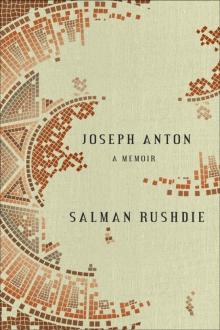 Joseph Anton: A Memoir: A Memoir
Joseph Anton: A Memoir: A Memoir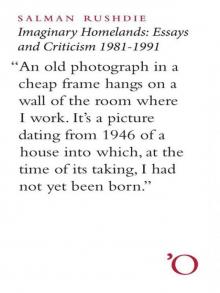 Imaginary Homelands
Imaginary Homelands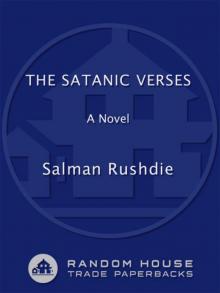 The Satanic Verses: A Novel
The Satanic Verses: A Novel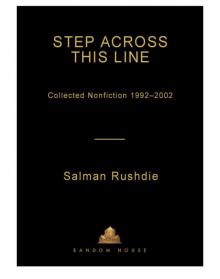 Step Across This Line
Step Across This Line East, West
East, West